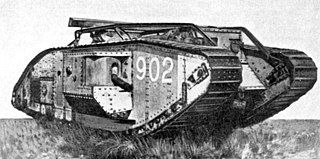
An armoured fighting vehicle (AFV) is an armed combat vehicle protected by armour, generally combining operational mobility with offensive and defensive capabilities. AFVs can be wheeled or tracked. Main battle tanks, armoured cars, armoured self-propelled guns, and armoured personnel carriers are all examples of AFVs.

A machine gun is a fully automatic mounted or portable firearm designed to fire rifle cartridges in rapid succession from an ammunition belt or magazine for the purpose of suppressive fire. Not all fully automatic firearms are machine guns. Submachine guns, rifles, assault rifles, battle rifles, shotguns, pistols or cannons may be capable of fully automatic fire, but are not designed for sustained fire. As a class of military rapid-fire guns, machine guns are fully automatic weapons designed to be used as support weapons and generally used when attached to a mount- or fired from the ground on a bipod or tripod. Many machine guns also use belt feeding and open bolt operation, features not normally found on rifles.
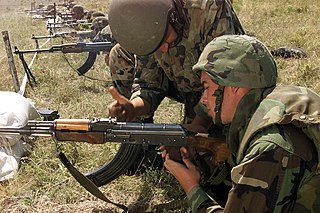
A squad automatic weapon, also section automatic weapon [SAW]; light support weapon [LSW]) is a fully automatic firearm used to give infantry squads or sections a man-portable source of fully automatic firepower. Weapons used in this role are often selective-fire rifles, usually fitted with a bipod and heavier barrel to perform as light machine guns. Squad automatic weapons usually fire the same cartridge as the assault rifles or battle rifles carried by other members of the unit. This reduces logistical requirements by making it only necessary to supply one type of ammunition to a unit. Squad automatic weapons are light enough to be operated by one person, as opposed to heavy machine guns such as the M2 Browning, which fire more powerful cartridges but require a crew to operate at full effectiveness.
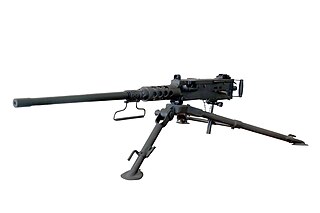
The M2 Machine Gun or Browning .50 Caliber Machine Gun is a heavy machine gun designed toward the end of World War I by John Browning. Its design is similar to Browning's earlier M1919 Browning machine gun, which was chambered for the .30-06 cartridge. The M2 uses the much larger and much more powerful .50 BMG cartridge, which was developed alongside and takes its name from the gun itself. It has been referred to as "Ma Deuce", in reference to its M2 nomenclature. The design has had many specific designations; the official designation for the current infantry type is Browning Machine Gun, Cal. .50, M2, HB, Flexible. It is effective against infantry, unarmored or lightly armored vehicles and boats, light fortifications and low-flying aircraft.

An autocannon or automatic cannon is a large, fully automatic, rapid-fire projectile weapon that fires armour-piercing or explosive shells, as opposed to the bullet fired by a machine gun. Autocannons often have a larger calibre than a machine gun, but are usually smaller than a field gun or other artillery. When used on its own, the word "autocannon" indicates a single-barrel weapon. When multiple rotating barrels are involved, the word "rotary" is added, and such a weapon is referred to as a "rotary autocannon". Modern autocannons are typically not single soldier-portable or stand-alone units, rather they are usually vehicle-mounted, aircraft-mounted, or boat-mounted, or even remote-operated as in some naval applications. As such, ammunition is typically fed from a belt to reduce reloading or for a faster rate of fire, but a magazine remains an option. They can use a variety of ammunition: common shells include high-explosive dual-purpose types (HEDP), any variety of armour-piercing (AP) types, such as composite rigid (APCR) or discarding sabot types (APDS).

The Maxim gun was a weapon invented by American-born British inventor Hiram Stevens Maxim in 1884: it was the first recoil-operated machine gun in production. It has been called "the weapon most associated with the British imperial conquest", and likewise was used in colonial wars by other countries between 1886 and 1914.

A gunship is a military aircraft armed with heavy guns, primarily intended for attacking ground targets.

A light machine gun (LMG) is a machine gun designed to be employed by an individual soldier, with or without an assistant, as an infantry support weapon. Light machine guns are often used as squad automatic weapons.
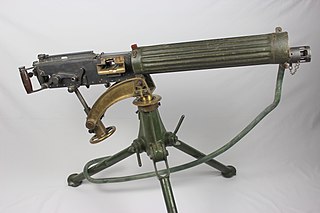
The Vickers machine gun or Vickers gun is a name primarily used to refer to the water-cooled .303 British (7.7 mm) machine gun produced by Vickers Limited, originally for the British Army. The machine gun typically required a six to eight-man team to operate: one fired, one fed the ammunition, the rest helped to carry the weapon, its ammunition, and spare parts. It was in service from before the First World War until the 1960s, with air-cooled versions of it on many Allied World War I fighter aircraft.

The DShK 1938 is a Soviet heavy machine gun with a V-shaped "butterfly" trigger, firing the 12.7×108mm cartridge. The weapon was also used as a heavy infantry machine gun, in which case it was frequently deployed with a two-wheeled mounting and a single-sheet armour-plate shield. It took its name from the weapons designers Vasily Degtyaryov, who designed the original weapon, and Georgi Shpagin, who improved the cartridge feed mechanism. It is sometimes nicknamed Dushka in Russian-speaking countries, from the abbreviation.
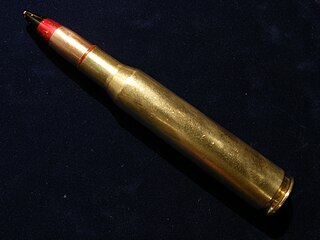
The 12.7×108mm cartridge is a 12.7 mm heavy machine gun and anti-materiel rifle cartridge used by the former Soviet Union, the former Warsaw Pact, modern Russia, China and other countries.
Rate of fire is the frequency at which a specific weapon can fire or launch its projectiles. It is usually measured in rounds per minute, or rounds per second.

A heavy machine gun or HMG is a class of machine gun implying greater characteristics than general purpose or medium machine guns.

The Type 1 Heavy Machine Gun was a heavy machine gun used by the Imperial Japanese Army during the Second World War starting from 1941.

The Panzerkampfwagen VII Löwe (Lion) was a design for a super-heavy tank created by Krupp for the German government during World War II. The project, initially code-named VK 70.01 (K), never left the drawing board, and was dropped in 5–6 March 1942, in favor of Porsche's heavier Panzer VIII Maus.
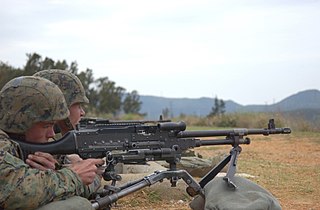
A medium machine gun (MMG), in modern terms, usually refers to a belt-fed automatic firearm firing a full-power rifle cartridge.

The Heavy Tank M6 was an American heavy tank designed during World War II. The tank was produced in small numbers and never saw combat.

The 13.2 mm Hotchkiss machine gun was a heavy machine gun designed and manufactured by Hotchkiss et Cie from the late 1920s until World War II when it saw service with various nations' forces, including Japan where the gun was built under licence.


















